Rajasthan Board RBSE Class 12 Chemistry Chapter 6 Principles and Processes of Isolation of Elements
RBSE Class 12 Chemistry Chapter 6 Text Book Type Questons
RBSE Class 12 Chemistry Chapter 6 Multiple Choice Type Questions
Question 1.
The formula of Haematite is
(1) Fe2O4
(2) Fe2O3
(3) FeS2
(4) FeO
Question 2.
Which metal is extracted from its ore by electrolytic method
(1) Pb
(2) Cu
(3) Al
(4) Ag
Question 3.
Galena is an ore of
(1) Ag metal
(2) Pb metal
(3) Cu metal
(4) Fe metal
Question 4.
The most abundant metal in the earth’s crust is
(1) Fe
(2) Al
(3) Ca
(4) Na
Question 5.
Fool’s gold is
(1) As2O3
(2) Sb2S3
(3) FeS2
(4) Alloy of Cu – Zn
Question 6.
Cryolite is an ore of
(1) Fe
(2) Al
(3) Cu
(4) Ag
Question 7.
Which of the following is not an ore of Aluminium
(1) Bauxite
(2) Corrundum
(3) Diaspore
(4) Azurite
Question 8.
Silver metal is extracted from its argentite ore by the method of
(1) self reduction
(2) carbon – reduction
(3) formation of Complex salt
(4) by electrolytic method
Question 9.
Magnetite is an ore of
(1) Mg
(2) Ag
(3) Mn
(4) Fe
Question 10.
Froth floatation process is used to concentrate which type of ores ?
(1) Sulphide ores
(2) Phosphate ores
(3) Silicate ores
(4) Oxide ores
Question 11.
Gravity separation method is used to concentrate which type of ores ?
(1) Sulphide ores
(2) Phosphate ores
(3) Silicate ores
(4) Oxide ores
Question 12.
Magnetic separation method is used for
(1) separating magnetic ores or gangue.
(2) separating coloured ores or gangue.
(3) separating colourless ores or gangue.
(4) none of the above.
Question 13.
Iron can be extracted from its oxide ores by which method ?
(1) Carbon reduction method
(2) Auto reduction method
(3) Carbon mono oxide reduction method
(4) Complex formation method
Question 14.
Copper can be extracted from its sulphide ore by
(1) electrolytic reductions
(2) formation of complex
(3) auto reduction
(4) carbon reduction
Question 15.
Those natural occurring components from which element can be extracted profitably and conveniently known as
(1) minerals
(2) gangue
(3) ores
(4) flux
Question 16.
Which type of furnace can create high temperature ?
(1) Blast furnace
(2) Reverberatory furnace
(3) Electric furnace
(4) Muffle furnace
Question 17.
In blast furnace, iron oxide is reduced by
(1) SiO2
(2) CO
(3) C
(4) CaCO3
Question 18.
When limestone is heated then CO2 gas is released. This process is known as in the metallurgy of metals
(1) Smelting
(2) Roasting
(3) Calcination
(4) Concentration
Question 19.
The impurities present with minerals are collectively known as
(1) Slag
(2) Flux
(3) Matrix
(4) Ores
Question 20.
The metal which always exists in free or native state is
(1) Au
(2) Ag
(3) Cu
(4) Na
Question 21.
A mineral is called an ore if
(1) The metal present in the mineral is costly.
(2) A metal can be extracted profitably from it.
(3) A metal can be extracted from it.
(4) A metal cannot be extracted from it.
Question 22.
During smelting, a compound is added, which combines with gangue and converted it into fusible product. This compound is known as
(1) Mud
(2) Slag
(3) Flux
(4) Matrix
Question 23.
The method of extraction of metal from its ore is known as
(1) Purification
(2) Concentration
(3) Calcination
(4) Metallurgy
Question 24.
Which of the following is used in froth floatation process for the benefication of ore
(1) Coconut oil
(2) Olive oil
(3) Pine oil
(4) None of these
Question 25.
Roasting is done in
(1) Oxide ore
(2) Silicate
(3) Sulphide ore
(4) Carbonate ore
Question 26.
What is blister copper
(1) Pure copper
(2) An ore of copper
(3) An alloy of copper
(4) Copper which has 2% impurity
Question 27.
Matte is
(1) FeS
(2) Cu2s
(3) Cu2S + FeS
(4) CuS + Fe2S2
Question 28.
The main ore of copper is
(1) Copper glance
(2) Cuperite
(3) Chalcophyrite .
(4) Malachite
Question 29.
On heating the mixture of Cu2O and Cu2S, we will obtained
(1) CuSO3
(2) CuO + CuS
(3) Cu + SO3
(4) Cu + SO2
Question 30.
Which of the following have minimum percentage of carbon ?
(1) Cast iron
(2) Malleable iron
(3) Steel
(4) All have same % of carbon
Question 31.
Lime stone is used as …… in the extraction of iron from haematite.
(1) slag
(2) flux
(3) reducing agent
(4) all of these
Question 32.
Which of the following have the highest percentage of impurities
(1) Cast iron
(2) Malleable iron
(3) Steel
(4) All of these
Question 33.
Fool’s gold is used to prepare ornaments which give lusture like gold. It is
(1) Iron pyrite
(2) Copper pyrite
(3) Cinnabar
(4) Cadmium sulphide
Question 34.
During the extraction of copper from pyrite slag is mainly made up of
(1) Cu2S
(2) CuSiO3
(3) FeSiO3
(4) SiO2
Question 35.
Froth floatation is based on
(1) specific gravity of the ore particles.
(2) wetting properties of the ore particles.
(3) magnetic properties of the ore particles.
(4) electrical properties of the ore particles.
Question 36.
Which of the following statement is true ?
(1) All ores are minerals.
(2) All minerals are ore.
(3) A mineral cannot be an ore.
(4) An ore cannot be a mineral.
Question 37.
Electrolytic reduction process is used for the extraction of
(1) Alkali metals
(2) Alkaline earth metals
(3) Aluminium
(4) All of the above
Question 38.
In thermite process, the reducing agent is
(1) C
(2) Zn
(3) Na
(4) Al
Question 39.
AG vs T plot in the Ellingham diagram slopes downward for the reaction
(1) Mg + \(\frac { 1 }{ 2 } \) O2 → MgO
(2) CO + \(\frac { 1 }{ 2 } \) O2 → CO2
(3) C + \(\frac { 1 }{ 2 } \) O2 → CO
(4) 2Ag + \(\frac { 1 }{ 2 } \) O2 → Ag2O
Question 40.
Which method of purification is represented by the following equation ?
4CO + Ni \(\underrightarrow { 70^{ o }C }\) [Ni(CO)4] \(\underrightarrow { 180^{ o }C } \) Ni + 4CO
(1) Mond’s Process
(2) Bessimerisation
(3) Cupellation
(4) Van-Arkel process
Answers:

RBSE Class 12 Chemistry Chapter 6 Very Short Answer Type Questions
Question 1.
Write name and chemical formula of oxide ore of aluminium and iron.
Answer:
(a) Bauxite [Al2O3.2H2O]
(b) Haematite [Fe2O3].
Question 2.
What is slag ? Explain with example.
Answer:
When flux is added to an ore, the impurities form a fusible product with flux, it is called slag.
Gangue + Flux → Slag (Fusible product)
Slags are generally fusible and are in the form of metal silicates and phosphates.
Question 3.
Write name and chemical formula of sulphide and oxide ore of copper.
Answer:
(a) Copper Pyrites [CuFeS2]
(b) Cuprite(Cu2O].
Question 4.
Write name of any two metals which are found in native state.
Answer:
Ag and Au.
Question 5.
Write the name of most abundant metal in earth’s crust.
Answer:
Aluminium (Al).
Question 6.
Write name and chemical formula of sulphide and oxide ores of zinc.
Answer:
(a) Zinc blende (Zn)
(b) Zincite (ZnO)
Question 7.
What is difference between mineral and ore. Explain it.
Answer:
The naturally occurring chemical substance in which metal occurs in the earth’s crust is called mineral. On the other hand, the mineral from which metal can be economically and conveniently extracted is called an ore.
Question 8.
How much carbon % is found in cast iron and pig iron ?
Answer:
% carbon in cast iron = 4%
% carbon in pig iron = 3%
Question 9.
Write composition of german silver.
Answer:
% Cu = 25 – 50
% Zn = 25 – 35
% Ni = 10 – 35%
Question 10.
What is anode mud ?
Answer:
The impurities of zinc, nickel, iron etc. get collected below the anode is known as anode mud.
Question 11.
Write name and role of collectors and froth stabilizers in froth floatation method.
Answer:
(i) Floatation Agent (Collectors):
These substances make the sulphide particles water repelling. So that the particles can float on the surface of water. Main floatation agent is sodium ethyl xenthate.
![]()
R = Ethyl or Alkyl group
(ii) Froth stabilizers:
They provide stability to froth. For example.
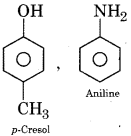
Question 12.
Write the name of two impurites present in bauxite ore.
Answer:
Bauxite usally contains equal amount of Fe2O3 and SiO2 as acidic impurities.
Question 13.
Write the chemical reaction of Mond’s process for refining of nickel.
Answer:
Ni + 4CO \(\underrightarrow { 330-350k } \) Ni(CO)4
(Impure Nickel)
[Ni(CO)4] \(\underrightarrow { 450-470k }\) +Ni+ 4CO
[Pure Nickel]
Question 14.
Which complex ions are used for electroplating of silver and gold ?
Answer:
Complex ions used for electroplating of silver and gold are (Ag(CN)2]– and [Au(CN)2]– respectively.
Question 15.
What is the role of depressants in froth floatation method?
Answer:
They are used for decreasing froth. For example : sodium cyanide (NaCN) and sodium carbonate (Na2CO3) etc.
Question 16.
Ruby and blue sapphire gemstone are impure form of which metal ?
Answer:
Ruby : Impurity of Cr in Al2O3
Blue sapphire : Impurity of Co in Al2O3
Question 17.
Anode and cathode are made up of which metal in electrolytic refining of metal ?
Answer:
Copper (Cu).
Question 18.
Write chemical reaction of reduction of metal chromium oxide in alumino thermite process.
Answer:
Cr2O3 + 2Al \(\overrightarrow { Thermal\\ reduction } \) 2Cr + A12O3
Question 19.
Write name and formula of example of each acidic and basic flux.
Answer:
Acidic flux – SiO2, Basic flux – CaO.
RBSE Class 12 Chemistry Chapter 6 Short Answer Types Questions
Question 20.
What is the significance of leaching in the extraction of Al metal?
Answer:
Leaching is significant in the extraction of aluminium as it helps in removing the impurities like SiO2, Fe2O3, TiO2 etc., from the bauxite ore.
Question 21.
Explain roasting and calcination with example.
Answer:
Roasting:
Roasting is a process of heating the ore in the presence of excess of air.
For example:
The impurities of non metals like sulphur, phosphorus, arsenic etc. are removed as the volatile oxides.
P4 + 5O2 \(\underrightarrow { \triangle }\) P4O10(g)
S + O2 \(\underrightarrow { \triangle }\) SO2(g)
4AS + 3O2 \(\underrightarrow { \triangle }\) 2A2O3(g)
Calcination:
Calcination is a process of heating the ore strongly in the absence or limited supply of air.
For example :
Fe2O3 3H2O \(\xrightarrow [ Calcination ]{ \triangle }\) Fe2O3 + 3H2O
Limonite (Brown haematite)
ZnCO3 \(\xrightarrow [ Calcination ]{ \triangle }\) ZnO+CO2(g)
Question 22.
Draw labelled figure of zone refining process. Where this process is widely used?
Answer:
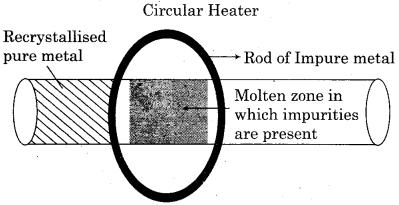
Semiconductors like silicon (Si) and germenium (Ge) are required in high grade of purity. These metals are extracted by this procces. This method is based on the principle that the impurities are more soluble in the molten form than in solid state of metal. On cooling pure metal recrystalises out of the melt while impurities remain in the form of melt in molten zone.
Question 23.
Draw labelled diagram of electrolytic cell for extraction of aluminium and write complete reaction of it. Answer:
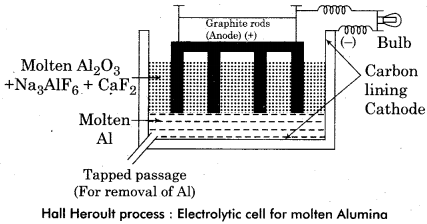
Following two concepts are there for the reaction taking place during electrolysis :
1. According to the first concept which is more famous, ionisation of alumina occurs firstly :
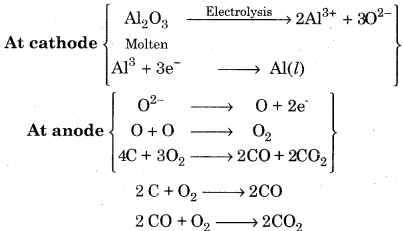
Hence, corrosion of graphite rods (anode) occurs and they have to be replaced periodically. For 1 kg of aluminium produced, about 0.5 kg of anode (graphite) is consumed.
2. According to the second concept, ionisation of ‘Cryolite’ occurs firstly on passing electric current.
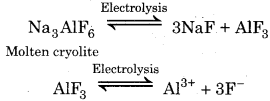
At cathode: Al3+ + 3e– → Al(l).
At anode: F– → F + e–
3C + 2Al2O3 → 4Al + 3CO2
At anode, Al2O3 is changed into AlF3 and the process of electrolysis continuously goes on when Al2O3 is again ionised.
The whole reaction may be written in the following way:
2Al2O3 + 3C → 4Al + 3CO
Molten aluminium thus obtained is collected at the bottom of cell which is taken out with the help of tap. The aluminium metal. obtained by this method is about 99.5% pure. The complete process is known as electrometallurgy.
Question 24.
Explain with equation how does copper purify by electrolytic method ?
Answer:
Copper is refined using an electrolytic method. In this method, crude copper is made anode, a thin sheet of pure copper is made cathode and acidified solution of copper sulphate is used as an electrolyte. On passing electric current, metal ions from the elecctrolyte are deposited at the cathode in the form of pure metal. On the other hand, an equivalent amount of metal dissolves from the anode into the electrolyte in the form of metal ions. The reactions occurring at electrode are :
At cathode : Cu2+ + 2e– → Cu
At anode : Cu → Cu2+ + 2e–
The impurities settle down below the anode in the form of anode mud.
Question 25.
Explain thermodynamic principle in : reduction of haematite ore from Ellingham diagram.
Answer:
According to Ellingham diagram :
- Temperature 1073K respresents intersection point.
- Reduction of haematite below 1073 K is done by carbon monoxide. Hence
∆G°(Fe → Fe2O3) > ∆G°(CO → CO2)
Reaction completes in following way:
Fe2O2(s) + 3C(g) \(\underrightarrow { <1073k } \) 2Fe(s) + 3CO2(g) - Reduction of haematite above 1073 K is done by coke (or carbon). Hence
∆G°(Fe → Fe2O3) > ∆G° (C → CO)
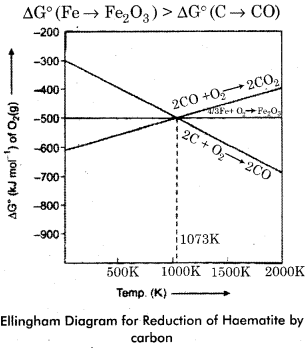
In this way reduction is as follows :
Fe2O3(s) +C(s) \(\underrightarrow { Temp>1073k }\) 2Fe(s) + 3CO(g)
Question 26.
Give example of following steps used in froth floatation method:
(i) Frothing agent
(ii) Collector/ Floating agent
(iii) Forth stabilizers
(iv) Activator
(v) Depressant or depresser.
Answer:
(i) Frothing Agent:
Examples :
Mainly fatty acid, pine oil and eucalyptus oil are good frothing agent.
(ii) Collector/Floating Agent:
Main floating agent is sodium ethyl xanthate.
![]()
(iii) Stabilizers:
Examples: Cresol and aniline
(iv) Activator:
Example: Copper sulphate (CuSO4)
(v) Depressant:
Example:
Sodium cyanide (NaCN), Base (Na2CO3).
Question 27.
Write the uses of following in aluminium metallurgy:
(i) Cryolite
(ii) Carbon or coke powder
(iii) Graphite rod.
Answer:
(i) Cryolite:
Melting point of pure alumina is 2323K which is a very high temperature and it is insulator of electricity in molten form. It’s electrolysis is very difficult. Hence in its metallurgy, fused alumina mixed with cryolite (Na3AlF6) and fluorspar (CaF2) are taken in the form of electrolyte. Their ratio is 20%, 60% and 20% respectively. Due to this, melting point of mixture reduces to about 1173K and cunductivity also increases by which alumina becomes conductor.
(ii) Carbon or Coke Powder:
Layer of carbon (coke) powder is applied by which heat loss due to radiation stops and hence protects it form cooling.
(iii) Graphite Rod:
Steel tank is lined inside with carbon which itself acts as cathode while a number of graphite (or carbon) rods dipping in the fused electrolyte serve as anode.
RBSE Class 12 Chemistry Chapter 6 Long Answer Type Questions
Question 28.
Write chemical reaction of Hall-Heroult process of bauxite ore and draw labelled diagram of elecrtrolytic cell.
Answer:

Following two concepts are there for the reaction taking place during electrolysis :
1. According to the first concept which is more famous, ionisation of alumina occurs firstly :

Hence, corrosion of graphite rods (anode) occurs and they have to be replaced periodically. For 1 kg of aluminium produced, about 0.5 kg of anode (graphite) is consumed.
2. According to the second concept, ionisation of ‘Cryolite’ occurs firstly on passing electric current.

At cathode: Al3+ + 3e– → Al(l).
At anode: F– → F– + e–
3C + 2Al2O3 → 4Al + 3CO2
At anode, Al2O3 is changed into AlF3 and the process of electrolysis continuously goes on when Al2O3 is again ionised.
The whole reaction may be written in the following way:
2Al2O3 + 3C → 4Al + 3CO
Molten aluminium thus obtained is collected at the bottom of cell which is taken out with the help of tap. The aluminium metal. obtained by this method is about 99.5% pure. The complete process is known as electrometallurgy.
Question 29.
Write short notes with example:
(i) Pyrometallurgy
(ii) Electrometallurgy
(iii) Hydrometallurgy
Answer:
(i) Pyrometallurgy:
The process of conversion of metal oxides to metal by heating vigorously at high temperature with reducing agent is known pyrometallurgy.
For example : Reduction of oxides of iron and copper is carried out in the blast furnace at high temperature.
Fe2O3 + 3C \(\underrightarrow { \triangle }\) 2Fe + 2CO
Fe2O3 + 3CO \(\underrightarrow { \triangle }\) 2Fe + 3CO2
(ii) Electrometallurgy:
Oxides, hydrides and chlorides of electropoitive metals like Na, K, Mg, Al,Ca are extracted by the electrolysis of their fused salts and pure metal is obtained on cathode. This is known as electrolytic reduction. It is based on electrochemical principle.
According to equation ∆G° = – nFE°, for a system (cell), difference of electrode potential for redox couple is positive, value of resultant AGo becomes negative by which more reactive metal goes in to solution and less reacive metal moves out of the solution, therefore it is released at cathode.
For example:
NaCl \(\xrightarrow [ Reduction ]{ Electrolytic }\) Na+ + Cl–
Fused form
At cathode: Na+ + e– → Na
At anode: Cl– → \(\frac { 1 }{ 2 } \)Cl2 + e–
(iii) Hydrometallurgy:
The process of extraction of metals by dissolving the ore in a suitable chemical reagent and the precipitation or displacement of the metal by more reactive or electropositive metal is called hydrometallurgy.
For example:
Conc. argentite Ag2S is first treated with a dilute solution of NaCN to form the soluble complex sodium dicyanoargantate (I).
Ag2S+ 4NaCN → 2Na[Ag(CN)2] + Na2S
Sodium dicyanoargentate (I) (soluble)
In the above complex, Zn metal is mixed and Ag metal is obtained by replacement.
2Na[Ag(CN)2] + Zn → Na2 [Zn(CN)4] + 2Ag ↓
Question 30.
Why silica lines are used in Bessemer convertor in reduction of copper oxide ? Write chemical reaction of it and draw labelled diagram.
Answer:
Because silica lines act as flux so it is used in Bessemer convertor in reduction of copper oxide. Chemical reactions which take place in Bessemer convertor are as follows:
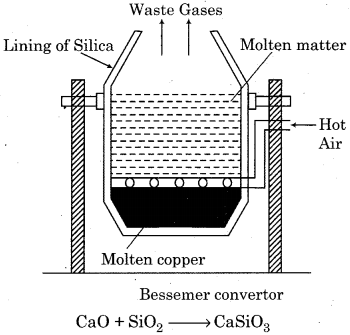
CaO + SiO2 + CaSiO3

Question 31.
(a) Which solution is used in presence of air for leaching of silver metal in silver metallurgy ? Write the reaction.
(b) Which reducing agent is good among C and CO at low temperature range in blast furnance to obtain iron form iron oxide and why?
Answer:
(a) Leaching in used to concentrate silver ore. In this method, the ore containing silver is treated with dilute solution (0.5%) of NaCN or KCN in the presence of – atomospheric oxygen. The matter disolves in the solution as a complex.
For example for Ag2S (argentite)

The above solution after filtration and removing impurities is heated with zinc to get silver metal.
![]()
(b) At lower temperature range, both C and CO act as reducing agent but in comparison with C, CO easily oxidises to CO2. Therefore at lower temperature range (Temp < 1073), CO acts as better reducing agent than carbon.
Question 32.
Which reducing agent is used to extract copper from copper ore (scrap copper), which has very low amount of copper in it? Explain.
Answer:
In low grade copper, copper is present in very less amount. It can be extracted by using acid. In presence of acid copper goes into solution in the form of Cu2+ ions.
2Cu(s) + 2H2SO4(aq) + O2(g) → 2CuSO4(aq) + 2H2O(l)
or
Cu(s) + 2H+(aq) + \(\frac { 1 }{ 2 } \) O2(g) → Cu2+(aq) + H2O(l)
Question 33.
Desribe principle of following methods in refining of metals :
(i) Electrolytic-refining
(ii) Van-Arkel method
(iii) Chromatography
(iv) Liquification
Answer:
(i) Electrolytic refining:
It is type of cell unit in which a thick rod of impure metal is made to act as anode whereas the thin sheet of pure metal is used as cathode. They are dipped in a suitable acidic solution of soluble salt of the same metal which is used in the form of electrolyte. On passing electricity, the metal from the anode goes into solution as ions due to oxidation while pure metal gets deposited at the cathode by accepting electrons. Refining of copper and zinc etc. is done by electrorefining method.
(ii) Van-Arkel Method:
Van-Arkel method is used for refining Zr and Ti. In this method, crude metal is heated with iodine to form volatile unstable compound. The compound is then decomposed to get pure metal.
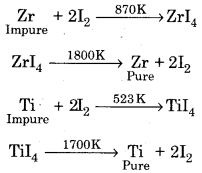
(iii) Chromatography:
Chromatography is a technique for the separation and purification based on the differences in the adsorbing tendencies of the metal and its impurities on a suitable adsorbent. It is based on the principle that different components of a mixture are differently adsorbed on an adsorbent.
(iv) Liquification:
This process is applied to the metals having low melting points such as tin or lead. The impure metal is placed on the sloping surface of reverberatory furnace and is heated in the inert environment of carbon monoxide. The metal with low melting point melts and flows down, which collected into a receiver. Solid impurities remains at the bottom of the vessel.
Question 34.
Draw labelled diagram and reaction of blast furnace in metallurgy of iron.
Answer:
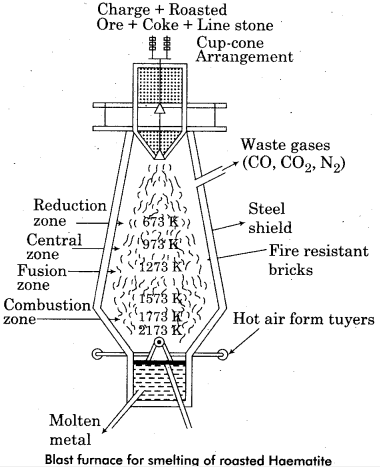
Main reactions which take place in the blast furnace are:
(i) Reduction zone:
(approx 673 – 978 K) At 673 K
3Fe2O3 + CO → 2Fe3O4 + CO2↓
Fe3O4 + CO → +2FeO + CO2↓
Fe2O3 + CO → 2FeO + CO2↓
This iron is porous and solid. It is known as spongy iron.
(ii) Central zone (Endothermic Region):
(approx 1173-1473 K)
CaCO3 \(\underrightarrow { 1273k }\) CaO + CO2↓
FeO + CO → Fe + CO2 ↓
![]()
(iii) Fusion zone:
(approx 1373 – 1573K)
In this zone, spongy iron melts and absorbs C, P, Si, etc.
CO2 +C → 2CO, ∆H = + 163kJ
(iv) Combustion zone:
(approx 1773K–2173K)
![]()
FeO + C → Fe + CO
Question 35.
Which ores are concentrated by froth floatation process. Write in brief description and draw labelled diagram.
Answer:
This process is generally used for the concentration of sulphide ores.
For example:
Copper pyrite (CuFeS2], Galena [PbS], Zinc Blende (Zn) etc.
Method:
Water is taken in a big rectangular utensil. In this, powdered ore is mixed and suspension is made. A very small quantity of floatation agents are added. The water is agitated by the blast of air.
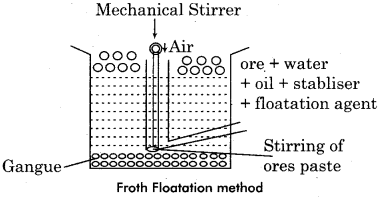
Due to which, light particles of sulphide ore carried out to the surface by the foam and from there they are skimmed off. The gangue particles are preferentially wetted by water sinks to the bottom of the tank.
Question 36.
Draw labelled diagram and reaction of furnace which is used in metallurgy of copper ore.
Answer:
In the concentrated ore, small quantity of silica is added and heated in the presence of excess of air in reverberatory furnace. During this, moisture and other volatile impurities are repelled in the form of oxide.
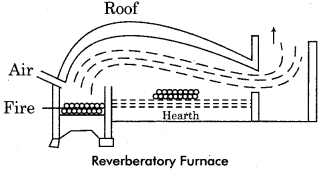
Following chemical changes occur in the furnace :
2CuFeS2 + 2O2 Cu2S + 2FeS + 2SO2 ↓
2FeS + 3O2 → 2FeO + 2SO2 ↓
2Cu2S + 3O2 → 2Cu2O + 2S02 ↓
![]()
Cu2O + FeS → Cu2S + FeO
This mixture Cu,Sand Cu, thus obtained is know copper matte.
Question 37.
Write short notes on following:
(i) Gangue/Matrix
(ii) Slag
(iii) Flux
Answer:
(i) Gangue/Matrix:
The unwanted earthy and silicious impurities e.g. sand, clay, rock etc. associated with the ore is called gangue or matrix.
(ii) and (iii) Slag and Flux:
Flux is a substance which combines with gangue which may still be present in the calcined or roasted ore to form an easily fusible material called the slag.
Flux + Gangue → Slag (fusible)
Question 38.
Describe metal refining by the following methods :
(i) Poling
(ii) Zone refining
Answer:
(i) Poling:
This method is used when the impure metal contains impurities of its own oxide. For example-Sno, in impure SnO2 and Cu2O in blister copper. The molten impure metal is stirred with green wood poles.
(ii) Zone refining:
This method is based upon the principle of fractional crystallisation. Semiconductors such as Si, Ge, Ga are purified by this process.
Question 39.
Value of ∆G° for formation of Cr2O3 and Al2O3 are -540 kJ mol-1 and -827 kJ mol-1 respectively. Is reduction possible of Cr2O3 by Al metal ?
Answer:
The two thermochemical equations can be written as:
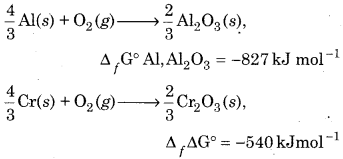
Subtraction equating (2) from equation (1), we get
![]()
∆rG° = -287 kJ mol-1
As ∆rG° of the combined redox reaction is -ve, therefore reduction of Cr2O3 by Al is possible.
Question 40.
Complete the following reactions :
(i) 2Cu2O + Cu2S → ……….. + ………
(ii) Ag2S + NaCN → ……….. + …………
(iii) Al2O3 + NaOH → …….. + ……..
(iv) CuFeS2 + O2 → ……….. + ………..
(v) Cu2S + ………… → ……. Cu + SO2
Answer:
(i) 2Cu2O + Cu2S → 6Cu + SO2
(ii) Ag2S + 4NaCN + 2O2 → 2Na[Ag(CN)2] + Na2SO4
(iii) Al2O3.2H2O7 + NaOH → 2NaAlO2 + 3H2O
(iv) CuFeS2 + O2= → Cu2S + 2FeS + SO2 ↓
(v) Cu2S + 2Cu2O → 6Cu + SO2 ↓